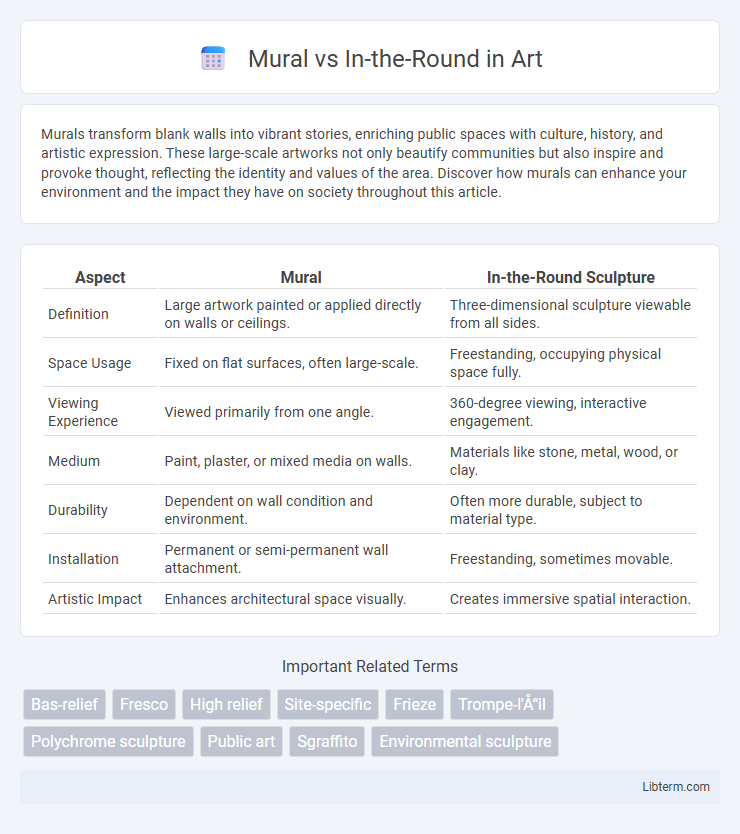Murals transform blank walls into vibrant stories, enriching public spaces with culture, history, and artistic expression. These large-scale artworks not only beautify communities but also inspire and provoke thought, reflecting the identity and values of the area. Discover how murals can enhance your environment and the impact they have on society throughout this article.
Table of Comparison
| Aspect | Mural | In-the-Round Sculpture |
|---|---|---|
| Definition | Large artwork painted or applied directly on walls or ceilings. | Three-dimensional sculpture viewable from all sides. |
| Space Usage | Fixed on flat surfaces, often large-scale. | Freestanding, occupying physical space fully. |
| Viewing Experience | Viewed primarily from one angle. | 360-degree viewing, interactive engagement. |
| Medium | Paint, plaster, or mixed media on walls. | Materials like stone, metal, wood, or clay. |
| Durability | Dependent on wall condition and environment. | Often more durable, subject to material type. |
| Installation | Permanent or semi-permanent wall attachment. | Freestanding, sometimes movable. |
| Artistic Impact | Enhances architectural space visually. | Creates immersive spatial interaction. |
Introduction to Mural and In-the-Round Art
Mural art transforms large wall surfaces into vibrant visual narratives, integrating cultural, historical, and social themes within public or private spaces to create impactful storytelling. In-the-Round art features three-dimensional sculptures or installations accessible from all angles, enhancing viewer interaction and immersive experience. Both forms emphasize spatial engagement but differ in their medium and audience interaction dynamics, with murals being two-dimensional and site-specific, while In-the-Round art invites circumnavigation and tangible connection.
Defining Mural Art
Mural art consists of large-scale paintings or designs directly applied to walls, ceilings, or other permanent surfaces, often reflecting cultural, social, or political themes. Unlike in-the-round sculpture, which is free-standing and viewable from all sides, murals are two-dimensional and viewed primarily from a single vantage point. Mural art transforms architectural spaces into immersive storytelling canvases that engage public and community interaction.
What is In-the-Round Art?
In-the-Round Art refers to three-dimensional sculptures or artworks designed to be viewed from all angles, offering a full, immersive experience without a dedicated front or back. Unlike murals, which are two-dimensional and affixed to walls, In-the-Round pieces engage viewers in a 360-degree interaction, emphasizing form, space, and physical presence. This sculptural approach highlights depth and volume, encouraging tactile and spatial exploration.
Historical Context and Evolution
Mural art has ancient origins dating back to prehistoric cave paintings and evolved through civilizations like the Egyptians and Romans, serving as visual storytelling and cultural documentation. In-the-round sculpture emerged during the Renaissance, emphasizing three-dimensional forms meant to be viewed from all angles, reflecting advances in artistic techniques and anatomical study. Both art forms illustrate the evolution of public and private artistic expression, with murals often integrated into architectural spaces and in-the-round sculptures standing as standalone works.
Key Techniques and Materials
Mural painting techniques involve applying pigments directly onto large wall surfaces using materials such as fresco, tempera, and acrylics, emphasizing durability and scale. In-the-round sculptures utilize three-dimensional forms crafted from materials like stone, bronze, or clay, enabling viewers to experience artwork from all angles. Both methods require mastery of spatial dynamics, with murals focusing on flat, expansive compositions and in-the-round works emphasizing volume and physical presence.
Visual Impact and Audience Engagement
Murals create a large-scale, immersive visual impact by covering extensive wall space with vibrant imagery, captivating viewers with detailed and dynamic compositions that tell a story or convey a message. In-the-Round setups place the audience around the performance or artwork, fostering intimate engagement and active participation as viewers experience the presentation from multiple perspectives. While murals provide a static, awe-inspiring backdrop that enhances spatial ambiance, in-the-round designs prioritize direct interaction and emotional connection, making each viewer feel integral to the creative experience.
Spatial Considerations
Mural presentations require ample wall space, ensuring that the artwork or visuals are visible from a fixed vantage point, optimizing viewer engagement through a structured spatial layout. In-the-Round setups maximize audience immersion by utilizing a centralized arrangement where observers surround the subject, demanding careful attention to 360-degree visibility and balanced spatial design. Each format influences spatial dynamics uniquely, with murals emphasizing linear viewing paths and In-the-Round prioritizing equal spatial distribution for all participants.
Artistic Challenges and Limitations
Mural art offers expansive creativity but faces limitations in scale, surface texture, and permanence, requiring artists to adapt to architectural features and weather conditions. In-the-round sculptures present artistic challenges through their demand for full 360-degree detail, structural integrity, and spatial interaction, limiting the material choices and increasing complexity in design and execution. Both mediums demand unique problem-solving skills, balancing artistic vision with technical constraints to achieve impactful visual narratives.
Prominent Artists and Iconic Examples
Prominent artists of the mural tradition include Diego Rivera, known for his large-scale works like the Detroit Industry Murals, which capture social and political narratives. In the in-the-round style, sculptors such as Auguste Rodin exemplify this approach with iconic pieces like The Thinker, designed to be viewed from all angles. These distinct artistic methods showcase the mural's narrative depth alongside the sculptural form's spatial engagement.
Choosing Between Mural and In-the-Round for Your Project
Choosing between mural and in-the-round techniques depends on the project's spatial context and audience engagement goals. Murals offer expansive visual storytelling on flat surfaces, ideal for public art and large-scale narratives, while in-the-round sculptures create immersive, 360-degree experiences that encourage tactile interaction and multidimensional perspectives. Evaluate the desired viewer interaction level and environmental integration to determine the most impactful medium for your artistic vision.
Mural Infographic

 libterm.com
libterm.com